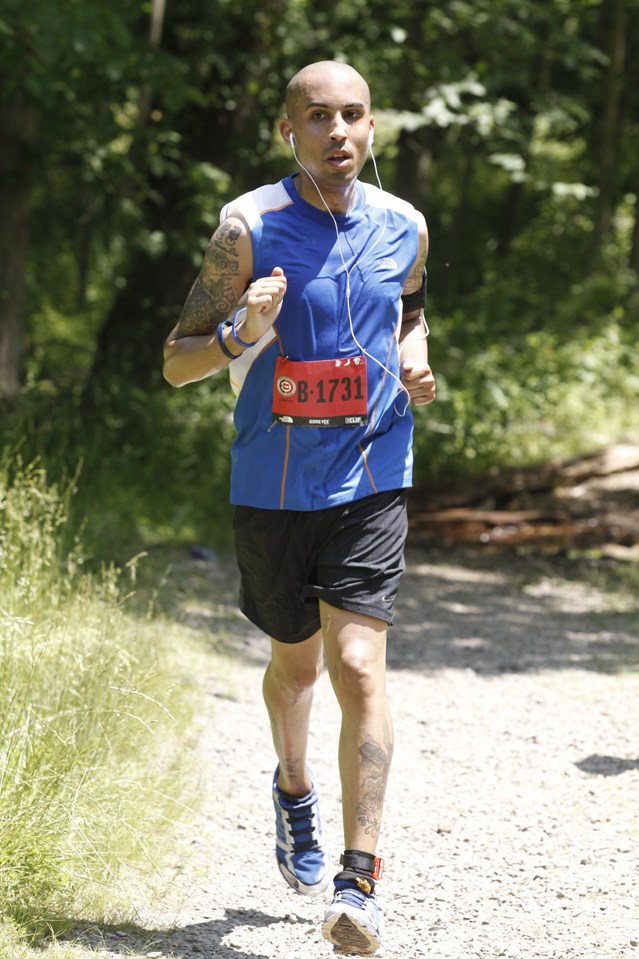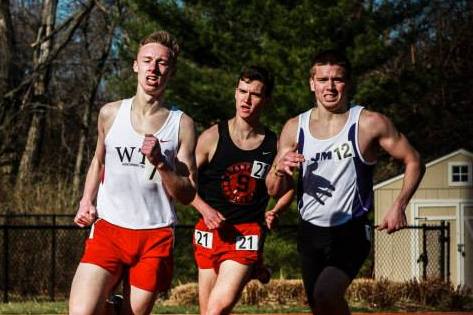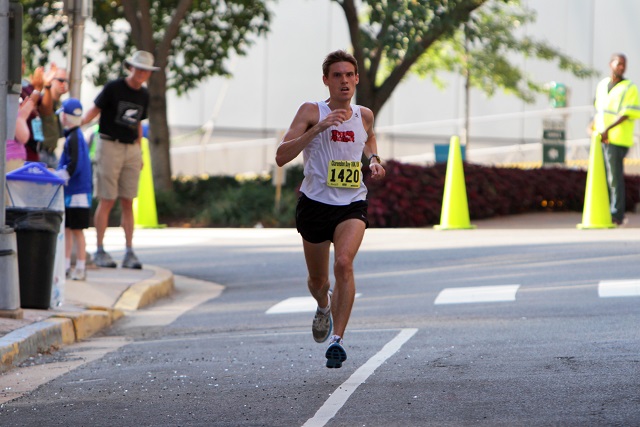
Jon Deitchman was 16 when he fell to the floor in the fourth quarter of his high school basketball game. He was having a heart attack.
“I wasn’t feeling good in the fourth quarter, got dizzy, passed out and woke up in the intensive care unit in a Fairfax hospital,” Deitchman, now 33, recalled. “It was terrible. To make it worse, just three weeks before that my mother passed away from a heart attack.”
The physical impact of the heart attack paired with the emotional stress of his mother’s death kept Deitchman from his main form of stress relief: sports. For eight years, he put dreams of resuming athletics behind him.
Now, 17 years later, Deitchman will be at the starting line of the Marine Corps Marathon to run in honor of his mother.
“I am running for her,” he said. “She wouldn’t give up.”
Heart defects are more common in boys than in girls, according to Brenner Children’s Hospital. “And basketball seems to be the riskiest sport, we think because of the quick sprints,” Dr. Wesley Covitz said on the hospital’s website.
Although they are rare, heart issues in athletes can be deadly.
According to the Cleveland Clinic, for athletes under 35, most sudden cardiac deaths occur in males while playing team sports. It’s rare – about one in 100,000 to one in 300,000 athletes – but shocking.
In athletes 35 years and older, sudden cardiac death occurs more often while running or jogging – about one in 50,000 marathon runners die annually.
It was a long road for Deitchman to get to the start line of his first marathon, the Baltimore Marathon in 2008.
The high school basketball game was to be Deitchman’s first game back since his mother had died. “It meant a lot for me to be playing in it,” he said. “I figured sports would help get my mind off what was happening at home.”
Instead what happened on the court changed his life. Within a few months, doctors regulated Deitchman’s heart with medication and a few years later after two surgeries, they gave him a clean bill of health. But nothing the doctors said changed the way Deitchman was feeling.
“I didn’t believe when the doctors said I was safe to be as active as I wanted so I still didn’t run,” he said. “I stopped playing basketball and running. I stopped doing everything for a long time because I was scared to move – scared to do anything at all. I was scared to even just walk through campus at George Mason.”
Deitchman said he couldn’t pinpoint exactly what was holding him back, but one day in his senior year of college, things changed.
“I looked at myself in the mirror. I decided ‘I am not going to live like this. I am going to let myself go out and run,’” Deitchman said. “I know that my mom would have been enraged if I sat at home and did nothing.”
“I laced up my shoes and went. I felt free. Good again. You do your greatest thinking when you’re running. I was able to get over what I’d been through over 8 years in a matter of three miles. I was addicted.”
The Marine Corps will be Deitchman’s fourth marathon, but he said it’s the most meaningful.
“For me this race means the most,” he said. “My father was in the Army, so supporting the military as a whole is important to me. It truly is the people’s marathon. Seeing Marines out there running in their full gear is so inspirational.”
Using Hal Higdon’s “Novice 2 marathon” training plan, Deitchman, a Fairfax resident, runs four or five times a week and is shooting for a sub-four hour race. But to him, the most important thing is getting out there.
“When I run I think about a lot of the kids who are in the hospital with heart conditions. I take those kids on my back because I was there,” Deitchman said. “If I had listened to all of the people in my life who said ‘don’t run’ or ‘you can’t do that’ I never would have gotten to where I am now. If you believe in yourself you can do it.”

It’s not unusual for Carolyn Ruth Carlson, of Chantilly, to be found grinding away on her stationary bike with science textbooks open or while looking at a PowerPoint presentation.
Choosing between a degree in biology and the triathlon team at James Madison University simply wasn’t an option.
“Sometimes I get distracted by the intervals, but usually I can get some studying done,” Carlson said.
Carlson is one of a number of local high school runners who leave the area without plans to continue representing their schools as varsity-level athletes. An estimated 92 percent of the nation’s high school runners fall in this category, but many are finding ways to continue pursing running outside of their colleges’ athletic departments.
The stakes aren’t as high as a Division I team, but the commitment is serious.
“I am a biology major and being on the tri team is a huge time commitment, but I love it,” she said. “These are the people I would want to hang out with, anyway. It’s exactly where I would want to be.”
Not all college-bound athletes find their fit as easily.
When Zach Weinstein was a junior at Winston Churchill high school in Maryland, everything was in place for a perfect final season that would land him on a college track team.
He was focused, logged the miles and was in touch with a number of schools and coaches about running on their teams. Then his training took a turn for the worst.
“The summer is an important time to get ready for cross country and I was hoping to do big things in the fall. I trained hard, too hard,” Weinstein said. “I overdid it and I got hurt.”
His college plan needed some revisiting.
“I wanted to do really well my senior fall because that’s a key time to seal the deal with coaches,” he said. “If I’d had a better cross country season I probably could have been able to run on a varsity team somewhere.”
Now a junior at Stanford, Weinstein had to blaze his own trail to find a place to fit his competitive-but-not-quite-varsity running style. The Stanford Running Club wasn’t quite what he was looking for.
“I was disappointed,” he said. “It was casual — show up a couple days a week if you feel like it. Which is great for a lot of reasons — and for a lot of runners — but not for me. I wanted to have a more serious structure, like in high school. I wanted to be competitive.”
Weinstein teamed up with other club members to form a more serious team. With the help of a few runners and a coach, the competitive branch of the Stanford Running Club now has two mandatory intense workouts a week, long runs and meets.
Looking back, Weinstein said he couldn’t imagine the time commitment it would take to run on Stanford’s track and cross country teams.
“I am amazed at what they can do,” he said. “I can’t imagine being a varsity athlete and traveling every weekend and taking serious classes alongside that.”
When it comes down to it, Weinstein said no varsity opportunity could have swayed him from his college decision.
“I think I really would have enjoyed being on a varsity team but I just couldn’t pass up Stanford,” Weinstein said. “If I went to another school and ran on varsity but the school didn’t have as good academics or social energy, I’d regret it if I got hurt.”
Erin Horil, another Chantilly alumna, was also plagued with injury from running in high school.
“In high school I ran all four years but I battled with a lot of different injuries,” Horil said. “I even broke my hip senior year.”
Although running was her passion, Horil said she knew she couldn’t run competitively in college without risking serious injuries. Like Carlson, Horil found the JMU triathlon team.
“I love it. I couldn’t be happier, honestly,” Horil said. “It was a bummer in high school not to be able to run as much as I wanted to.”
Now, because of the triathlon’s diverse training program, she is swimming, biking and running injury-free. The combination, she said, is perfect for her.
Leaving a rigid high school schedule and a familiar home environment means big changes for any college-bound senior.
Especially without the help of athletic department staff, a foreign place with new friends, a sleep schedule turned upside-down, and unlimited amounts of less-than-ideal food can be barriers to focused training.
More than a million high school students run on track and cross country teams every year but only 8 percent continue on to run in college, and only part of them on varsity teams.
What about the other 92 percent?
The Collegiate Running Association is working to get them back in their running shoes.
The non-profit group partners with well‐established races and offers prize money for college runners: casual runners, club teams, elite runners, anyone with a passion for running.
“We want the 95 percent of high school runners that do not compete in the NCAA to stay in the sport and excel,” co-founders Steve Taylor and Jon Molz write in the organization’s welcome letter.
The only requirement for those interested in competing in a Collegiate Running Association race is that the participant be enrolled in at least one college course.
“We’ve seen athletes coming out of high school who want to compete in a sport but they are only going to college for one reason — to get their education,” Taylor said. “Maybe they don’t have time to dedicate to a full-blown Division I or II or III program with traveling on top of that. It just won’t work for them. We want to be very inclusive. The whole point is to provide running opportunities to any college student here in the United States.”
There are roughly 450 NCAA athletic programs that do not sponsor year-round running programs, the Collegiate Running Association reports. The group also wants to provide an opportunity for runners at schools that only have offer either cross country or track and field.
“As I got into coaching I realized that we coach some very strong, very good athletes, young men and women who were very capable of being competitive in their careers,” said Taylor, who is also a NCAA Division I cross country and track and field coach at the University of Richmond. “But there were not a lot of opportunities for them. So I thought ‘what can we do in our country to help people stay in the sport?’ There are more and more limits and less and less opportunities for high school athletes that want to compete in college.”
In March, more than 3,600 college students went to Richmond to compete in the first Collegiate Running Association National Championship, a 10k run as part of the Monument Avenue 10k. The mountain running championship was held July 6 in New Hampshire. “The NCAA doesn’t cover road racing, mountain and trail running,” Taylor said. “We wanted to create a competitive opportunity for that, too.”
The opportunities to run in college on a club level are appealing to many runners not ready or able to make the varsity commitment. The benefits extend beyond fitness.
Horil’s club team provides the flexibility she needs for a well-rounded college experience as a kinesiology major.
“Training can take up so much time,” she said. “Sometimes I need to stop and think: ‘Do I really do another training session today or should I be spending time with my friends. Do I want to stay out late with my friends or go to bed early so I can wake up early and feel good for my workout?’ You have to balance it.”
This article first appeared in the September/October RunWashington.

If the conditions are right, competitive marathoner Scott Allen, 27, of Washington, D.C., has his eyes on a PR in Boston.
It’s an ambitious goal.
A personal record at the monumental 2014 Boston Marathon on April 21 would mean beating his current record of 2:36:05 from the 2012 Rock ‘n’ Roll USA Marathon, where Allen placed third overall.
“Boston – there really is no experience like it,” Allen says. “I can only imagine how big the energy will be after last year’s bombings. It would really be great to PR.”
Allen came in 157th in the 2011 Boston Marathon and he is optimistic for another great run this year.
Because of the response to last year’s bombings and a higher number of qualifiers, though, the field is much bigger.
Allen had the same qualifying time as in 2011, when his bib number was 262. This year it’s in the 400s, which means there are an additional 200 people who had a faster seed time.
“It’s going to be huge,” he says. “It’s cool being a part of something that shows our response to last year’s bombings. We are not going to let this bombing deter us. People aren’t going to let that ruin such a big day for Boston and the country.”
After running the Rock ‘n’ Roll USA half marathon in March, Allen suffered a leg injury that kept him from running for two weeks. “This injury kind of set me back,” he says. “But I feel like I am almost back to where I need to be. I am not sure if I am going to be in my PR shape but I will have a solid race.”
Before the taper started, bringing him down to a weekly 55 miles, Allen averaged about 80 miles a week on some of his favorite routes: along the mall, by the Georgetown Waterfront, Capital Crescent Trail, Haines Point, Custis Trail – where he heads for the hills – and Rock Creek. “There isn’t really anywhere where I don’t like running,” he says.
“This season the most I did in one week was 82 miles,” Allen says. “I was hoping to get closer to 90 but I had a muscle injury and just wasn’t able to.”
Ideally, when he is feeling healthy, Allen takes only one day off a month.
A peak week usually includes a long run of 20-22 miles and two workouts – hard hill repeats and two by four miles at goal half marathon pace. The other days are filler runs – 8-10 miles– sometimes a bit more.
As for fuel, Allen loves his carbs. “The night before a race I like to have pasta – eat a big meal. For breakfast? A bowl of cereal.”
He doesn’t go for the healthy stuff. Cocoa Krispies did the trick in Delaware. Cinnamon Toast Crunch was his go-to before this weekend’s 20-mile long run. He isn’t sure which cereal it will be for Boston, but he plans to eat a lot of it, he says with a laugh.
As a third year law student at Georgetown, Allen is trying to get as much competitive running in as he can.
“I don’t know if it will be possible to run this much and be a lawyer,” Allen says. “I am just not sure if I can be quite as intense when I am working, but running is not something I am going to give up.”
Although he’s always been a runner, Allen didn’t know he’d have a gift for marathons until he crossed the finish line of his first: the 2009 Marine Corps Marathon.
“I had no idea how I would do on race day,” Allen says. “But I ended up with 6:08 miles. Being good made we want to keep going.”
Allen is originally from Wisconsin. He went to Marquette University where he ran cross-country and track.
“I’ve been running since middle school,” he says. “But I didn’t get into the 80 plus area until I started doing marathons. Some bodies just cannot withstand high mileage but I have good genes, good muscular structure.”
The highest mileage he ever did in one week was 102 – before Boston in 2011.
“That was kind of crazy,” Allen says. “It’s better to think long term. Do 60 miles a week and be healthy rather than trying to push it to 80. If you do that much you’re bound to get hurt.”
Allen is not exempt from that. A knee injury kept him out of last year’s Boston Marathon.
“It is disappointing to put in a lot of time and then get injured,” Allen says. “Every season I get another injury and I always think – ‘this could be the thing that takes me out of the season.’”
But so far, no injury has been bad enough to keep him from lining up in the first wave of runners in Boston later this month.
After Boston, Allen plans to take it easy until the fall season picks up. “You can’t be intense the whole year. I need those breaks from running a little bit,” he says. “After the marathon I’ll take one week of no running. I like to take it easy for a couple months and do no more than 30 or 40 a week. For the fall I’ll start in June to pick it up to 60.”
Now, Allen runs on the Pacers-New Balance racing team. On Boston Marathon Monday, he’ll be sporting a team black jersey and shorts. “I’ll be wearing New Balance because they sponsor our team,” he says.
For now, it’s all about getting to the starting line safe and healthy. And Allen’s focus is all Boston.
“With what happened last year, there will be even more energy so the whole atmosphere will be really neat,” Allen says. “There is nothing quite like being in a marathon with that many spectators. Nothing like Boston.”

